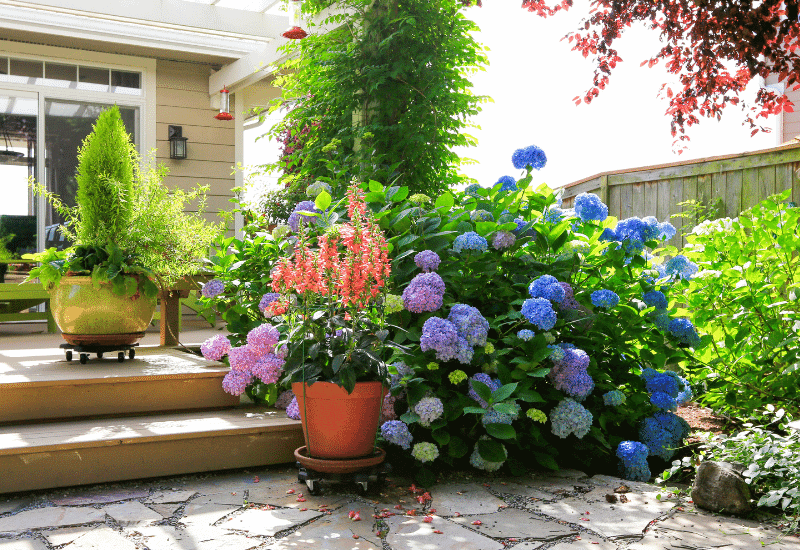
If your small urban garden running out of room for those giant tree-size lilacs or rhododendrons, dwarf flowering shrubs can fill those spaces where full-size shrubs either won’t fit or simply don’t suit.
These low-growing beauties will add much needed vertical interest, color and texture without take up all the space you have in your yard.
In fact, we can all be tempted to tinny sizable plants in limited spaces, but they will soon grow out of proportion and make your green haven look even more crowded and messy…
But this won’t be a problem if you pick right-sized varieties of your your favorite shrubs that will fit in perfectly in your yard.
Plus, dwarf trees can even be grown in containers to add vibrant blooms and sweet scents to your front porch, patio or deck.
From massive bloomers like chenille to brightly colored bloomers like ‘Blue Tit’ rhododendron, there are lot’s of dwarf or miniaturized varieties of flowering bushes which will remain fairly small when it reaches maturity (typically height of 1 to 3 feet).
Newer varieties also offer longer bloom periods, colored foliage that offers year-round curb appeal.
Here are our favorite small flowering shrubs, along with a guide to when they bloom, and landscaping ideas for how and where to plant them.
12 Dwarf Flowering Shrubs That Are Great for Small Gardens
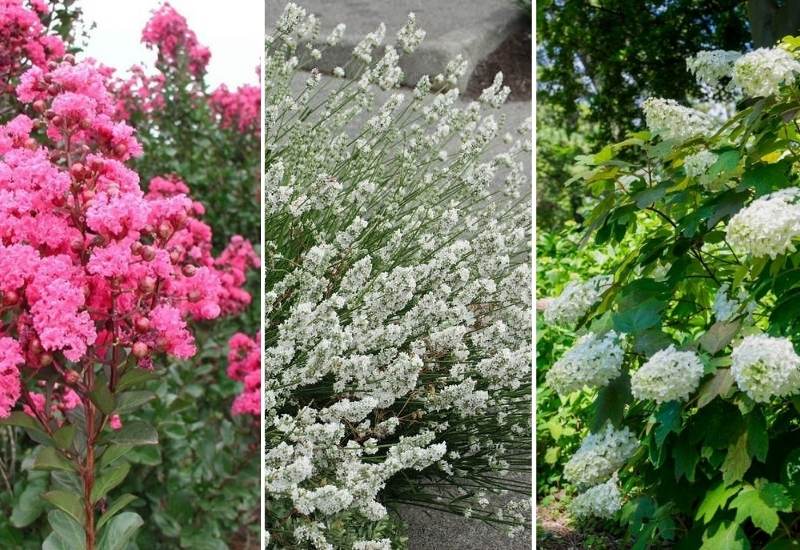
We picked the very best 12 tiny shrubs with big blooms for you, and here here are 12 varieties of flowering bushes for year-round color and beauty.
1. Dwarf Chenille (Acalypha reptans)

Dwarf chenille is a small marathon blooming shrub you won’t regret growing in a small garden. It produces plumes of crimson red inflorescences that look like tails, and they come in spring, summer, fall and even winter!
Each spike is 3 inches long (8 cm), and you will expect many of these exotic beauties to crop up on the bright green, ovate, dense and fresh looking bright green foliage.
It is ideal for humid climates, and you can grow it with very little work, experience and time to spend. A perfect solution for a tine low maintenance yard.
Dwarf chenille will also adapt to pots and hanging baskets, and it is excellent for herbaceous borders and flower beds in informal gardens, on its own or with other plants.
What you need is just a small property and an informal design, especially a traditional looking garden.
2. ‘Blue Tit’ Rhododendron (Rhododendron ‘Blue Tit’)
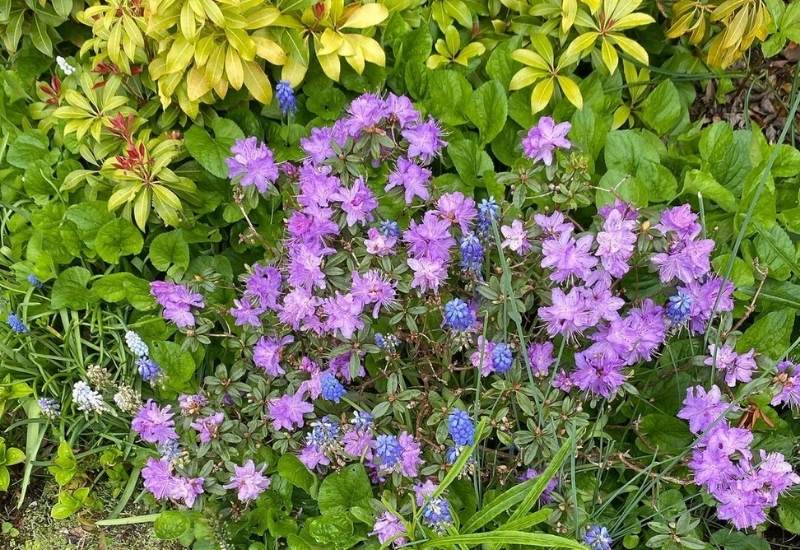
Some rhododendrons are huge, but ‘Blue Tit’ is a smaller variety which only grows to 3 feet tall (90 cm), so you can enjoy the spectacular blossoms of this Asiatic shrub even in a modest suburban or city garden.
The flowers cover the whole plant for a few weeks, and they are very showy, trumpet shaped and bright blue violet in color.
Don’t worry if they are a bit pale at first; as the plant matures, they will become more and more rich in color!
They form large round clusters between which you can get a glimpse of what comes next… The very finely textured, rich glossy green foliage which will keep you company all year round.
‘Blue Tit’ rhododendron was bred by J. Waterer with small gardens in mind; it also tolerates shady places, which makes it ideal for Japanese inspired designs, but honestly, in any formal garden and even in containers, this is a real asset for any informal space.
3. Groundcover Rose ‘Flower Carpet Pink Supreme’ (Rosa ‘Flower Carpet Pink Supreme’)
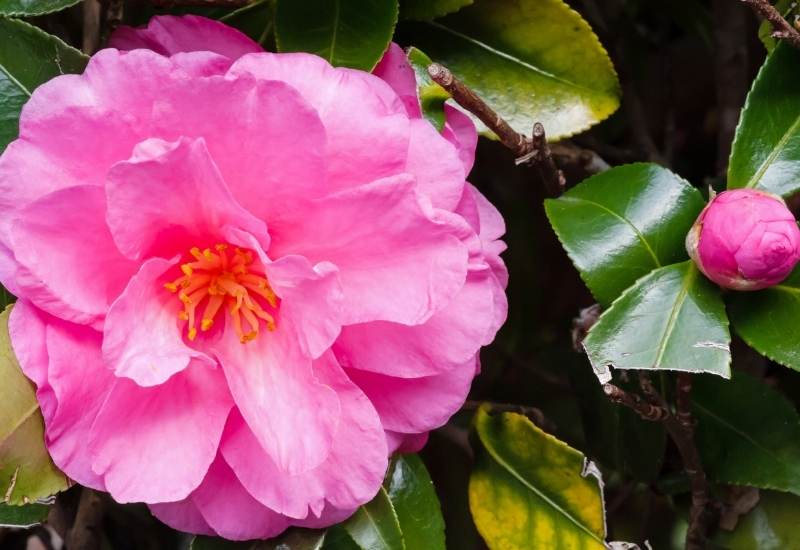
In a small garden you don’t even need to renounce roses, and some are quite small, like ‘Flower Carpet Pink Supreme’ which grows only 2 or 3 feet tall (60 to 90 cm) and you can keep even narrow with pruning.
But in this small space, this shrub will give you up to 2,000 flowers each year! They will come in dense clusters of semi double, lipstick pink blooms from spring to frost, never stopping and almost covering the plant in full.
Each head is small, 2 inches across (5.0 cm), but there is real strength in numbers. It also has thick glossy dark emerald green foliage, which is also very healthy, a rare quality in roses.
‘Flower Carpet Pink Supreme’ is ideal for traditional looking gardens, from English country styles to urban and suburban ones.
It can also grow in part shade, and it is ideal of you want a small corner of bright colors and you don’t have time or space to grow more than one small shrub.
4. ‘Little John’ Bottlebrush (Callistemon viminalis ‘Little John’)
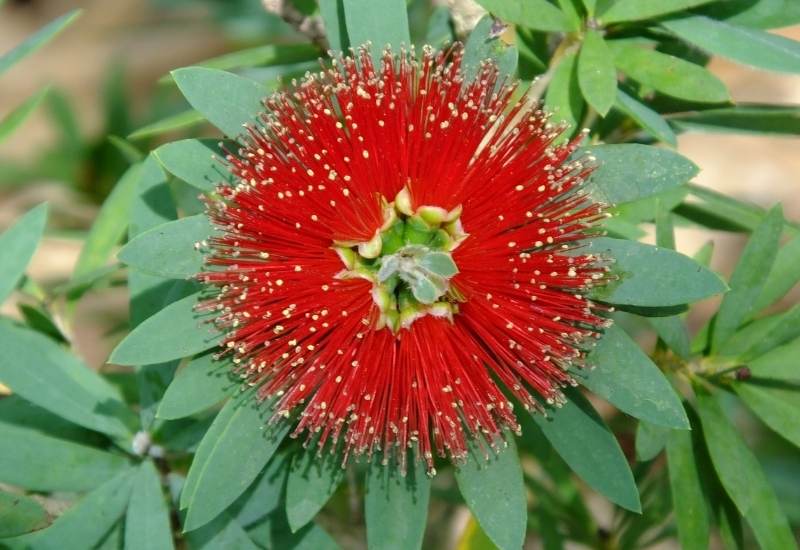
‘Little John’ bottlebrush is the ideal tiny blooming shrub for a sunny and exotic small garden. It has all the qualities of its bigger sisters: bright red blooms that look like bottlebrushes (hence the name) that open repeatedly all year round.
Very decorative, fine oval blue green and hard foliage that stays on in winter too, because it’s evergreen.
A very tropical, unusual and surprising look and all this is tied to a natural elegance in habit and appearance. But unlike other Callistemon varieties, it only grows to a diminutive 3 feet tall (90 cm)!
It can compact so much beauty into a tiny bush that it has won the Award of Garden Merit by the Royal Horticultural Society.
‘Little John’ bottlebrush is perfect for small tropical, exotic and Mediterranean gardens, but it will really add a touch of class and originality to urban, suburban, courtyard and gravel gardens as well.
5. Chinese Fringe Flower ‘Jazz Hands Dwarf Pink’ (Loropetalum chinense ‘Jazz Hands Dwarf Pink’)

‘Jazz Hands Dwarf Pink’ is a dwarf variety of Chinese fringe flower with delicate blooms for a small garden.
They have the typical “spider shape” of the flowers of larger Loropetalum varieties, and they come in abundance in spring, with their bright hot pink color.
But this tiny shrub has another ace up its sleeve: the evergreen foliage is dense, oval, bushy and of a dark purple shade!
It also has a very beautiful shape, as it looks like a soft and broad cushion with its prostrate habit and draping branches..
‘Jazz Hands Dwarf Pink’ Chinese fringe flower is an excellent shrub for small gardens that need a splash of color all year round; it will perfectly suit containers too, and most informal landscaping styles. It will also tolerate heat, which makes it suitable to sunny places.
6. Dwarf Fothergilla ‘Blue Mist’ (Fothergilla gardenii ‘Blue Mist’)
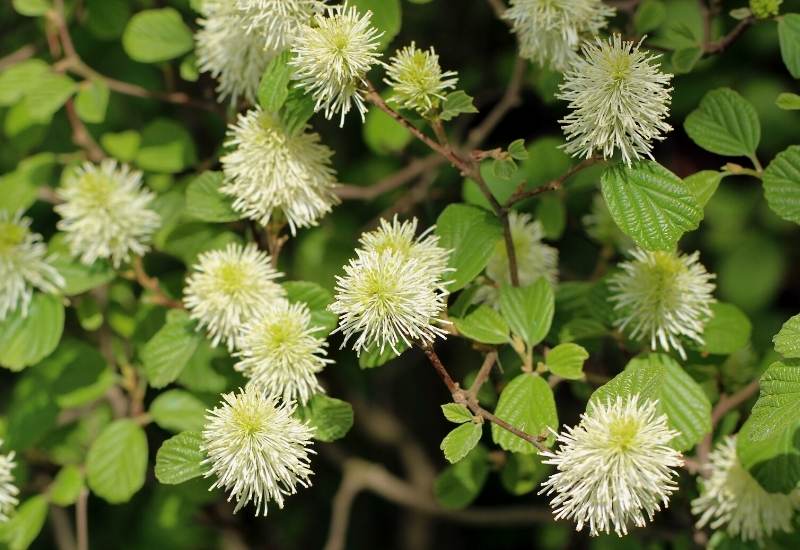
‘Blue Mist’ is a dwarf variety of fothergilla that gives you a delicate looking shrub for small, elegant gardens. In spring, it produces many white, bottle brush inflorescences with a strong scent of honey at the tips of the branches.
This adds to the beauty of the round, emerald to dark green glossy leaves. However the foliage will turn blue green over the hot season. So, in summer you will get an unusually colored bush to lift your yard. And in fall, the leaves change color once again, turning yellow, orange and even red before falling. It is a winner of the Gold Award Medal by the Pennsylvania Horticultural Society.
‘Blue Mist’ fothergilla is a lovely small shrub for a continuously changing display of colors through the season; it is perfect in borders, and it will work well in all informal garden designs, including Asian ones, thanks to its color and bright foliage.
7. Coastal Azalea (Rhododendron atlanticus)
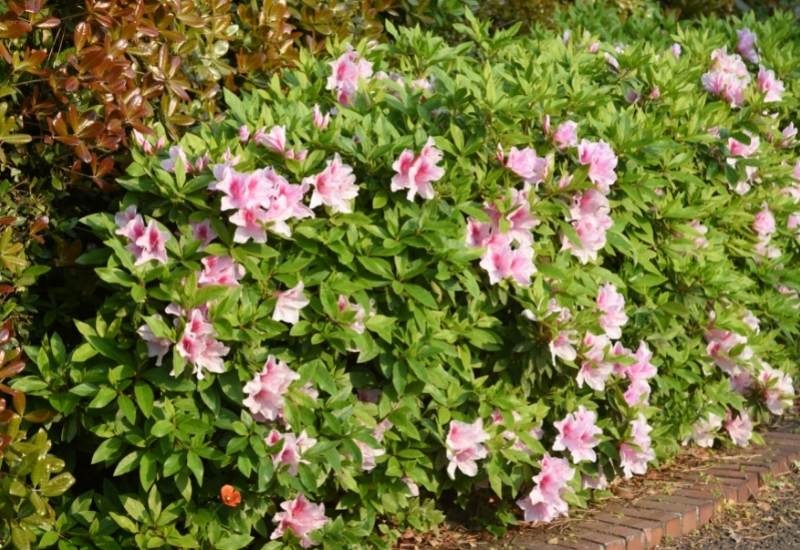
Coastal azalea is also called dwarf azalea, because it does not grow taller than 3 feet (90 cm) and it can bring its beautiful blooms to small gardens with little space.
These will come in large numbers in spring; the flowers have a long trumpet shape, they are white with pink blushes towards the tips of the petals.
They are really elegant and with an exotic touch to them. The foliage is elliptical, fairly dense and unusually colored, blue green. These will come in spring and then drop with frost, as it is a deciduous variety. It is also a winner of the Rhododendron of the Year Award by the American Rhododendron Society.
Coastal azalea needs a place that’s protected from winter winds, maybe with a north wall; this is quite common in small gardens, especially urban and suburban ones. If this is your case, you can enjoy its beautiful blooms in any informal style, even in shady corners.
8. ‘Happy Face Hearts’ Shrubby Cinquefoil (Potentilla fructosa ‘Happy Face Hearts’)
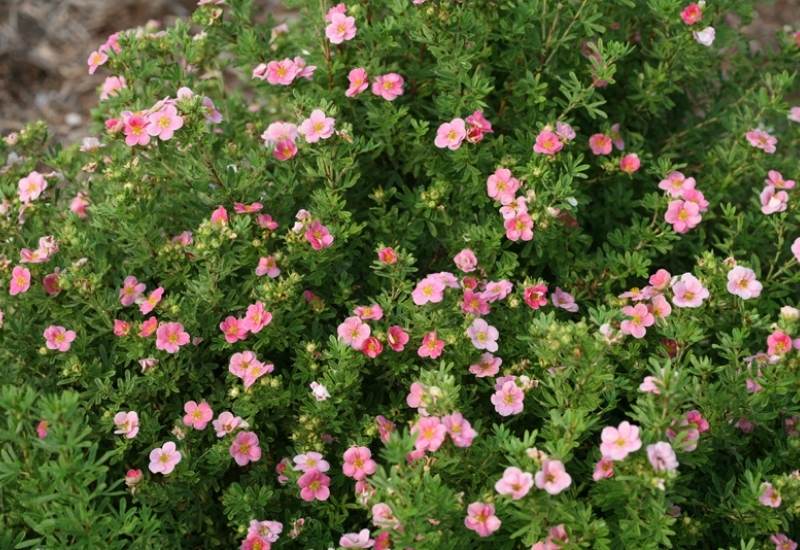
Sweet looking ‘Happy Face Hearts’ shrubby cinquefoil is one of the smallest varieties of Potentilla, ideal for modest gardens.
The round flowers look very delicate and romantic, with rich pink petals that pale to white towards the center, where you find bright golden yellow anthers. These come in huge numbers from spring to frost, giving you a great spectacle.
The foliage too is really decorative… Made up of many, thick and tiny segmented leaves, it has a wonderful texture. On top of this, it is a tiny but strong bush, that withstands both dry places and cold winters.
‘Happy Face Hearts’ shrubby cinquefoil is a low maintenance shrub for any urban or suburban gardens, even of minute size, even in very cold regions, like the Northern States, Canada and Northern Europe, and especially if you want to get a lot for very little work…
9. ‘Little Honey’ Oakleaf Hydrangea (Hydrangea quercifolia ‘Little Honey’)
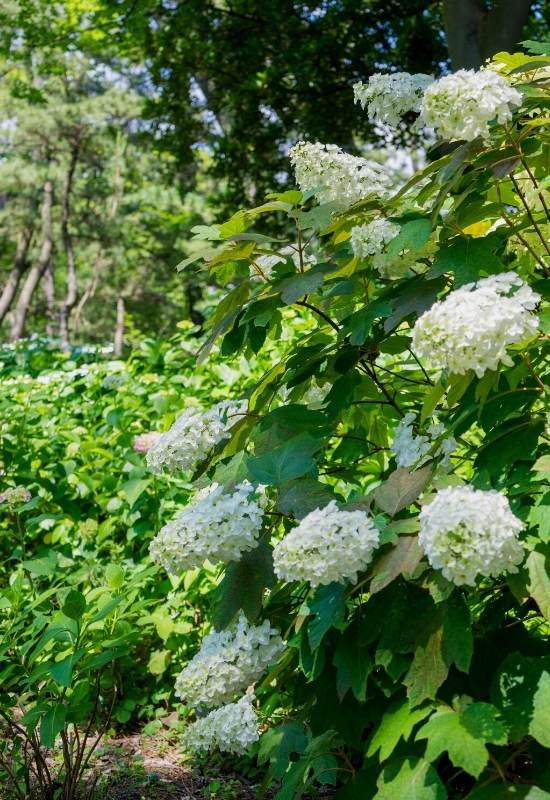
For a small hydrangea variety that suits fresh looking but tiny gardens, look at oakleaf variety ‘Little Honey’. Its cream white flowers form beautiful round clusters that reach 5 inches across (12 cm) and they start in summer, but on occasion they will come back in small too.
The leaves are deeply lobed, like those of oak trees, and they start off lime green in spring, but they turn chartreuse in late summer and they finally end with crimson red shades as the season approaches a close.
This will give your yard a lovely spectacle of colors for many months, with an ever changing dwarf shrub.
‘Little Honey’ oaklleaf hydrangea is suitable to all types of naturalistic gardens, even under trees. You can use it as a focal point thanks to its colors or even mix it in with other plants in short borders to add a touch of interest.
10. ‘Infinity Watermelon’ Dwarf Crape Myrtle (Lagerstroemia indica ‘Infinity Watermelon’)
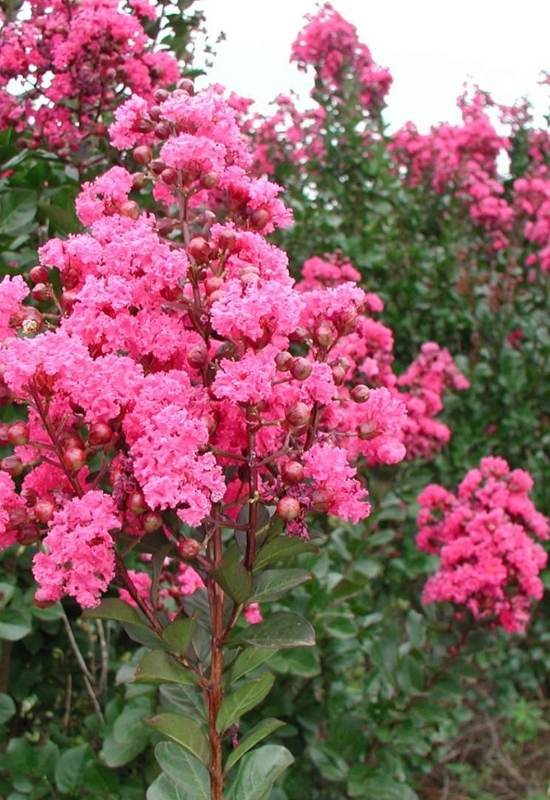
‘Infinity Watermelon’ dwarf crape myrtle brings vibrant blooms from small gardens from summer to fall. It has clusters of watermelon colored blooms that are very compact but also finely textured thanks to the many wavy petals that it packs together.
These appear at the end stems that emerge from the dense foliage. The many elliptical leaves form a cushion of green that turns to yellow and then red as the cold season approaches. But even when bare, during winter, thus small shrub offers you a nice spectacle with its beautiful peeling bark.
This way, you will have a source of interest for four seasons with a single bush of modest size!
‘Infinity Watermelon’ dwarf crape myrtle has a decorative but wild look, it is the sort of shrubs you would expect at the margins of forests, but in a very small scale indeed. It is perfect for herbaceous borders but also containers.
11. ‘Flutterby Petite Blue Heaven’ Butterfly Bush (Buddleja ‘Flutterby Petite Blue Heaven’)
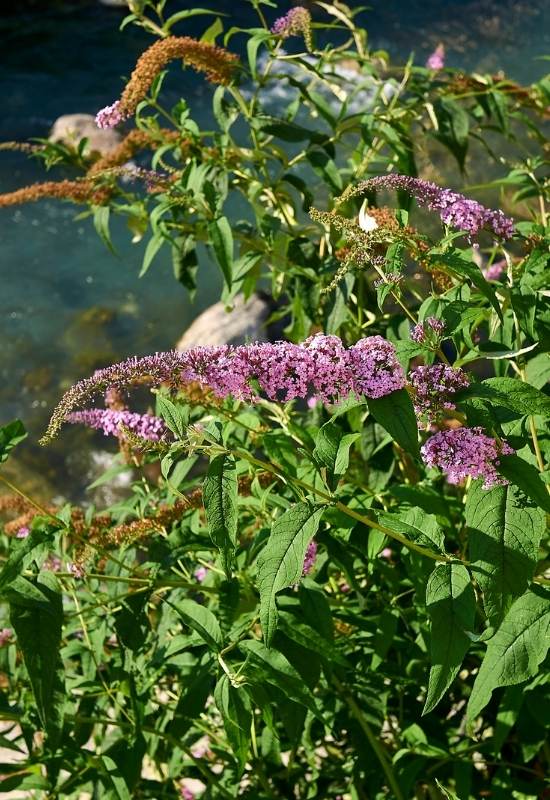
‘Flutterby Petite Blue Heaven’ butterfly bush is small, as the name says, and with lovely violet blue panicles of flowers that will look great in a small garden. And they will also fill it with their sweet scent and, of course, butterflies, that love this small shrub.
The stems have an upright habit, but the plant has an overall round shape. Many silver green elliptical leaves form a dense cloud from spring to frost, before falling as winter starts. It has a herbaceous appearance and an unruly look, but it is all expressed within 3 feet in size (90 cm)!
‘Flutterby Petite Blue Heaves’ is a diminutive but strong shrub which looks great in sunny places, in borders and even flower beds, or containers as well, as long as your little yard has a very informal, naturalistic inspiration.
12. ‘Nana Alba’ English Lavender (Lavandula angustifolia ‘Nana Alba’)
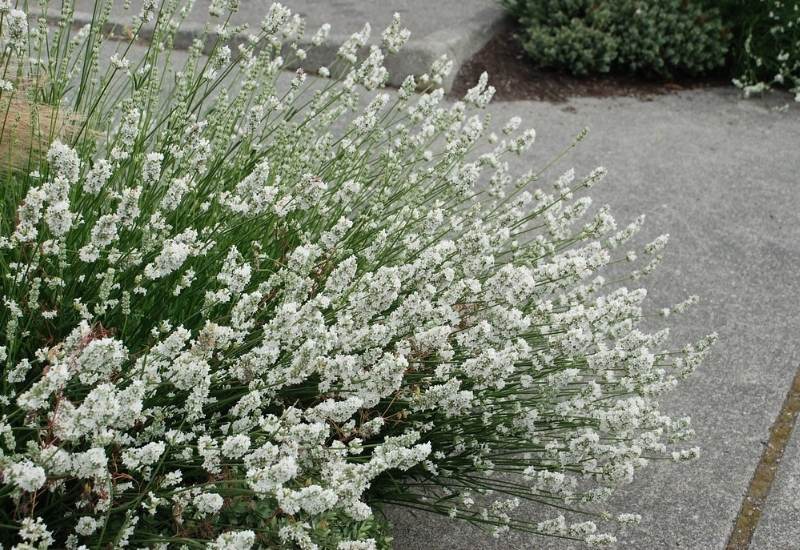
Most lavender varieties will suit a small garden, but we picked ‘Nana Alba’ for two reasons: it’s one of r smallest and it is also very original. In fact, it will never grow any taller than a single foot in height (30 cm), and this makes it perfect for even the tiniest yard, actually, even for window boxes! Add the snow white flowers, quite broad for lavender, lacked tightly together on the fragrant panicles and you can see why it is so special.
The foliage is finely textured and silver green in color, which perfectly suits the blooms. And, no need to say, it will attract a sea of pollinators, bees and butterflies to your little green space… No wonder it has won the Award of Garden Merit by the Royal Horticultural Society!
‘Nana Alba’ English lavender is ideal for all sunny gardens even in fairly cold regions; it will adapt to all informal designs, bringing a touch of Mediterranean vitality and vibrancy, though with a candid look too.
Dwarf Shrubs with the Beauty of Giants!
Your garden may be small, but it deserves big blooms and lots of beauty, and with these dwarf shrubs, you won’t have any problem achieving it.

Written By
Amber Noyes
Amber Noyes was born and raised in a suburban California town, San Mateo. She holds a master’s degree in horticulture from the University of California as well as a BS in Biology from the University of San Francisco. With experience working on an organic farm, water conservation research, farmers’ markets, and plant nursery, she understands what makes plants thrive and how we can better understand the connection between microclimate and plant health. When she’s not on the land, Amber loves informing people of new ideas/things related to gardening, especially organic gardening, houseplants, and growing plants in a small space.
